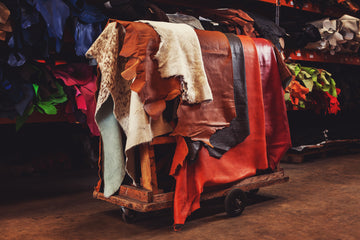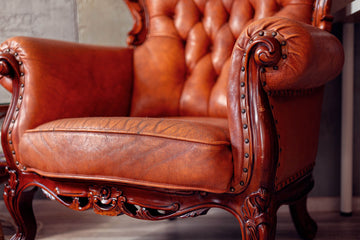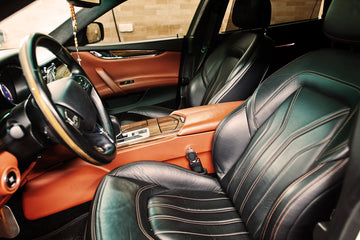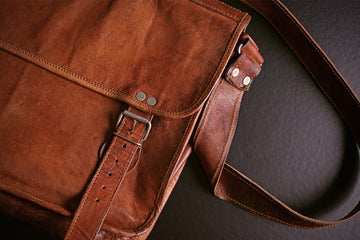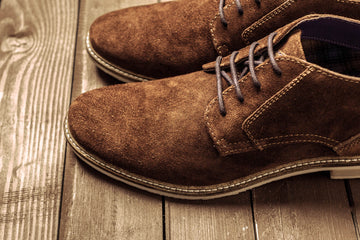Stepping into a leather shop usually means being hit with a flood of words-stamped, stitched, finished, treated-and the three big, age-old labels: genuine, top-grain, full-grain, each waving its tiny flag. Given that the global leather trade now tips the scales at more than 400 billion dollars, knowing how to spot the real deal and tell good hide from cheap hide matters if you want your money to stretch as long as the product.
Manufacturers sometimes use terminology intentionally, obscuring the picture so that words that sound high-end still conceal subpar materials, and many shoppers never discover the truth until years later. For example, genuine leather sits near the foot of the ladder, quietly packaging recycled leftovers and presenting itself as something it is not. A sturdy, full-grain or top-grain piece, by contrast, can withstand decades of use with only a yearly wipe of cream, while bargain leathers fracture, fade, and peel long before the stain from that spilt coffee has even dried.
This guide breaks down the lingo, arms you with simple tests-scuff, sniff, stretch-and shows exactly what to look for, whether you need a cosy sofa, a sharp handbag, or a rugged jacket ready for weekend camping. By the time you close the last page, you will move through any store with the calm of a collector, spotting premium hides, avoiding clever gimmicks, and buying pieces that age as well as you will.
Understanding Leather Basics
Leather begins as a raw hide, most often beef but also sheepskin, goatskin, pigskin, or skin from speciality animals, and is cleaned, preserved, and tanned through several meticulous steps. Once that work is done, the material is referred to simply as leather. Every hide has three main layers, and the makeup of those layers shapes how the finished product looks and feels.
The grain layer sits at the top. Its packed collagen fibres show natural marks—scars, pores, and tiny wrinkles—from the animal's life, and its thickness heavily judges the leather quality and what the piece can be used for. Craftspeople value this skin most because it shows the authentic surface and keeps the original texture. Beneath the grai, in the corium, forms a looser, more fibrous middle band. The bottom, termed flesh, holds fat tissue that producers usually trim away during processing.
Most of leather's appealing traits-long wear, flexibility, and the way a surface slowly darkens with use-come from those three layers working together and the dense collagen that gives strength while still allowing a little give.
Quality variations arise from three primary factors:
-
Animal type: Different animals yield leather hides with unique properties; cowhide offers toughness, while calf or lamb leather provides softness.
-
Processing methods, including tanning techniques, finishing processes, and cutting methods, have a significant impact on the appearance, feel, cost, and intended use of the product.
-
Craftsmanship: Meticulous construction, stitching, and finishing elevate the quality and longevity of the final product.
Understanding these fundamentals helps to recognise why high-quality leather, with its natural beauty and authentic natural marks, commands premium pricing and delivers superior value over time through improved aesthetics, durability, and tactile experience.
The Leather Production Process
Turning a fresh animal hide into the beautiful leather you see on sofas, bags, and jackets blends time-honoured skill with smart technology, and it takes several steps done one after another, always with an eye for detail. Understanding how each grade of leather is made and witnessing the process from start to finish can deepen your appreciation for full-grain pieces and similar hides, such as top grain or corrected grain.
The journey begins with selecting the right hides, with beef from mature cattle accounting for the majority, while hides from sheep, goats, and even some exotic animals also make an appearance. Once they arrive at the tannery, each hide is scrubbed, dehaired, and fleshed to strip away fat, muscle, and any leftover impurities, leaving a clean, even canvas waiting for the next treatment.
The Leather Grading System Explained
Today's leather makers categorise their goods into grades based on the hide section they use and the treatment they apply. This system makes it easier for buyers to see how long the jacket, sofa, or bag will last, how it will look from the start, and what the total cost will be.
Full-grain and top-grain leather appear on almost every quality list because they retain more of the skin's original character, withstand daily use, and feel rich to the touch. Split leather sits lower in the hierarchy, yet if it is carefully sanded, buffed, and then sealed, it becomes what people call finished split leather. That added work improves its look and toughness far beyond plain split, giving the piece a neater finish and the extra strength needed in busy homes.
Full-Grain Leather Identification
Full-grain leather sits at the pinnacle of the leather-quality spectrum. It comes from the entire top layer of the hide, leaving the skin untouched, so nothing is sanded or buffed away. Because of this, the material shows its true self, slight ridges, small pores, old bits of scars, and all the little stories the animal carried with it. Instead of hiding those signs, craftspeople celebrate them, making every piece genuinely one-of-a-kind.
When examining full-grain leather, look for:
-
Natural grain patterns: Irregular, non-repeating surface textures unique to each hide
-
Visible natural markings: Scars, pore marks, and slight colour variations
-
Firm yet supple feel: Significant thickness with natural flexibility
-
Matte to lightly glossy surface: Avoids heavily processed, plastic-like appearances
Full-grain leather is simply dyed with clear aniline stains, allowing the hide's original scars, pores, and texture to remain visible. Aniline leather takes this idea further by getting almost no top coat, so every mark on the surface remains unchanged. People love it for that honesty, the soft feel, and the deep, warm patina that gradually builds as the skin is handled. Semi-aniline leather combines the same dye with a light, pigmented layer, providing extra protection while concealing minor scratches or colour streaks.
Because full-grain loses almost nothing through finishing, its patina forms quickly: the colour deepens, the surface shines, and oils from hands are absorbed like a slow sponge. This durability, strength, and resistance to scuffs, along with its willingness to age nicely, make it the go-to choice for furniture, belts, wallets, or anything expected to last for decades. Watch a piece for a few years, and the leap in appearance proves that well-made full-grain leather rewards careful use almost like a living canvas.
Top-Grain Leather Recognition
Top-grain leather comes from the same top layer of the animal hide as full-grain leather, but it undergoes a gentle sanding or buffing process to smooth out minor marks. That bit of processing leaves a clean look while still retaining much of the original hide's strength. The makers usually add a pigment finish afterwards, into what people call pigmented leather. Because of that finish, the surface has an even colour, stands up better to daily use, and is less likely to show scuffs and stains.
Key identification features include:
-
Smoother, more consistent surface: Less pronounced natural markings
-
Uniform thickness: More regular feel throughout the material
-
Softer, more pliable texture: Enhanced flexibility compared to full-grain
-
Subtle grain patterns: Present but less pronounced than full-grain alternatives
Manufacturers employ several processes—plating, embossing, and coating—to modify a leather hide's surface, ensuring it looks and feels just right. Protective finishes are typically applied to top-grain hides, enhancing their resistance to stains but sometimes compromising their breathability. Although this leather is still of high quality, it typically develops a less dramatic patina over time than full-grain grades do.
Genuine Leather Detection
Although it sounds respectable, the term 'genuine leather' refers to the scraps left over after the top grain has been shaved away. Manufacturers treat these pieces through washing, tanning, dyeing, and finishing until they achieve an even appearance and a synthetic texture that conceals their origin.
Identifying characteristics include:
-
Artificial grain patterns: Repeated, stamped textures that lack natural variation
-
Plastic-like feel: Stiffer, less supple texture compared to grain leathers
-
Synthetic smell: Chemical or artificial odours rather than rich, earthy leather scents
-
Limited breathability: Reduced porosity due to heavy coating and processing
Bonded leather is often grouped with genuine leather, yet it is made from bits of leather dust and scraps glued together with synthetic material. The end product is inexpensive, but its quality and toughness fall short.
Genuine leather goods typically appeal to shoppers who are mindful of their budget, but these items tend to age and wear out much faster than those made from higher-grade hides.
Split Leather and Suede Characteristics
Split leather comes from the layer beneath the outer grain after the top layer has been removed. Because of this, the final hide is softer, more pliable, and much easier to bend, yet it lacks the strength of full-grain versions. That added suppleness makes split leather a popular choice for jackets, handbags, or furniture padding, where comfort, appearance, and everyday usefulness take precedence over maximum toughness. If the flesh side is lightly buffed and coated, it turns into soft suede, a material well known for its signature velvety feel.
Identification features include:
-
Napped surface texture: Fuzzy, raised fibre appearance in suede applications
-
Thinner, more flexible feel: Less substantial than grain leathers
-
Reduced durability: More susceptible to damage and wear
-
Stain susceptibility: Absorbs liquids and marks more readily
Split leather can receive coatings or finishes to improve appearance, but simple durability tests reveal its limitations compared to grain leathers.
Different Types of Leather by Processing
Beyond standard grading, leather is processed in many ways, resulting in specific types that suit different uses. Nubuck leather begins as top-grain hide that has been lightly sanded on the outside, resulting in a velvety feel similar to suede, yet tougher due to the underlying grain remaining intact. The surface is soft to the touch, yet the leather still holds its shape under everyday stress.
Distressed leather is created by deliberately rubbing, fading, or even soaking the hide, making it appear years older than it is. This purposeful weathering gives a rich, rugged patina that fans of bags, boots, and classic jackets find very appealing.
Patent leather undergoes a high-gloss finish created with several layers of lacquer, resulting in a mirror-like polish that withstands moisture while catching the eye as soon as it is set down.
Bicast leather starts with split hide that is coated in a sheet of polyurethane or PVC; the shiny, uniform surface can be attractive, but the lack of breathability and the risk of the laminate peeling away over time can disappoint buyers.
Finally, hair-on hide leaves the animals' natural hair in place after tanning, resulting in a showy, rough-finish material that works well for accent pillows and other speciality pieces.
Corrected grain leather has a smooth, consistent finish because it is sanded and stamped, giving it a thicker, slightly plastic touch that some find less natural. That added thickness, however, is also why many makers choose it for gear that needs to take a real beating day after day.
Because leather can be shaped, dyed and aged in so many ways, it stars in everything from the classic biker jacket to high-end living-room couches. Jackets showcase the hide's stretch and strength, while upholstery grades sit quietly on sofas, offering the same toughness wrapped in a calmer, richer appearance.
Careful eyeballing reveals each hides story-the fuzzy nap of nubuck and suede, the slick synthetic gleam of bicast, or the unmistakable brush of hair left on true hair-on hides. A few seconds of inspection can reveal to a craftsman or buyer which finish lies beneath the surface.
Tanning Methods and Quality Impact
The tanning process transforms freshly removed hides into durable leather that can withstand daily wear and tear. Two main techniques dominate the market, each leaving its own unique fingerprint on the finished product.
Vegetable tanning relies on tannins extracted from tree bark, leaves, and other plant materials. The result is a stiff, dense leather that withstands harsh treatment yet breathes well. Its warm, uneven brown hues deepen into a striking patina as the years pass, telling the story of every scrape and exposure to sunshine. Properly maintained, vegetable-tanned pieces-everything from saddles to wallets-can still be in service fifty years later.
Chrome tanning, on the other hand, utilises chromium salts for a quick and budget-friendly turnaround. The process takes only days, producing leather that bends, folds, and snaps without cracking. Brilliant reds, electric blues, and neon greens abound thanks to the method's forgiving dye acceptance. Though chrome tanners carefully finish liners for water spills, the fibres tend to resist visual ageing less dramatically than their vegetable cousins.
Because feel and colour are tied to the tanning process, users should also consider the footprint and final use. Eco-conscious shoppers note that avocado-leaf and tree-tannin stages spend months in water, demanding land and waste control. Even so, chrome-ready leathers can sometimes appear on clearance after a short life, raising disposal concerns. Fashion bags and linings favour the flash and flexibility of chrome, while sheaths and tool belts require patina-ready, long-haul vegetable tanned grades.
When shoppers consider synthetic options, they often encounter PVC leather, a faux material created by layering vinyl over a fabric backing. Although it resembles genuine leather, the production process is still tied to fossil fuels, and this connection raises concerns because factories can emit a range of harmful pollutants during the manufacturing process.
Physical Tests to Assess Leather Quality
Every day, leather checks enable shoppers to assess quality without relying on fancy gadgets or expert assistance. Run your fingers over the hide; good leather should feel warm, supple, and gently 'leather-soft', not stiff or overly squeaky. Trust these straightforward tests to point you to well-made hides that have been properly cared for.
Touch Test
Real leather warms softly against the skin, a subtle yet noticeable difference that every long-time wearer eventually comes to appreciate. Push it lightly and the mark fades almost at once; that quick recovery proves the fibres inside were carefully tanned. Premium hides are weighty yet buttery soft, while cheaper cuts can seem flimsy, rigid, or oddly gummy under the finger.
Smell Test
Real leather carries a warm, natural scent that many people find comforting and earthy. In contrast, most man-made materials either smell synthetic or barely give off any odour at all. Bonded leather or heavily treated genuine hides might have a slight chemical whiff from the glues and finishes used in production.
Visual Inspection
Look closely at the surface for subtle quirks that prove a hide is genuine. Authentic leather carries one-of-a-kind pores, tiny scars, and shading that you simply won't find elsewhere. Man-made covers, by contrast, tend to show the same repeated print or sit impossibly smooth and even. Also, see that a dyed full-grain piece has colour that runs through evenly, not just on the surface. Finally, give the whole section a once-over for obvious flaws, streaking, bubbles, or patchy hue; top-quality leather will always feel silky and display a steady, clean finish.
Thickness and Weight Evaluation
Better-quality leather usually sits heavier and feels denser than you might expect from its outer appearance. Thickness plays a significant role in how experts judge leather; full-grain and top-grain hides often weigh noticeably more, providing makers with the toughness they desire for products that endure daily use. On the other hand, genuine leather or bonded sheets can seem almost flimsy, even though they occupy roughly the same space.
Identifying Real vs. Fake Leather
Differentiating between real leather and synthetic kinds, as well as genuine and fake leather, requires examining a few key indicators and occasionally conducting simple hands-on tests. The primary challenge lies in distinguishing genuine leather from its popular man-made counterpart, which shoppers encounter everywhere. Both categories live under the broad umbrella of processed leather because each piece is cleaned, tanned, dyed, and finished to achieve the final look. To obtain a clear answer, buyers should pay attention to the feel, appearance, smell, and subtle details that reveal how the material was treated during its production.
Label Analysis
Learn to interpret common labelling terms:
-
"PU leather," "vegan leather," or "bonded leather" indicate synthetic materials
-
"Genuine leather" confirms real leather but suggests lower quality
-
"Full grain" or "top grain" indicates higher-quality natural leather
-
Absence of specific terms often suggests synthetic materials
Texture Analysis
Natural leather displays irregular grain patterns with unique pore placement and occasional scars or marks. Synthetic materials exhibit repeated patterns created through manufacturing processes, lacking the random variation found in natural hides.
Edge Examination
Real leather edges appear slightly rough and may reveal tiny threads when examined closely. In contrast, fake leather has a glossy, sealed edge that almost feels like plastic. That distinction is evident when you cut the material in cross-section and examine the inner layers.
Water Absorption Test
Put a single drop of water on a hidden spot. Genuine leather soaks it up slowly and turns darker for a moment; synthetic leather usually just lets the bead sit there without absorbing it. Be cautious when doing this, though, so you don't accidentally mark the item.
Quality Indicators in Leather Products
Several construction features indicate superior craftsmanship and high-quality materials in finished leather goods.
Stitching Check
Inspect the stitches closely for consistency, straightness, and sturdy reinforcement. Good leather work shows tidy, straight rows done with thick, tough thread. Bad stitching is wobbly, uses flimsy thread, or has loose knots where the bag bends or pulls.
Build Quality
Fine leather pieces have neatly trimmed edges, tightly joined panels, and careful burnishing or folding along seams. Premium items skip visible glue, relying instead on screws, rivets, or just precise fitting.
Hardware Test
Top-tier leather goods utilise solid steel or brass buckles, rivets, and clips, rather than lightweight, hollow metal or plastic. Each piece should feel dense in the hand and move smoothly, without sticking, rubbing, or jamming.
Finish Uniformity
A quality finish shows even, streak-free colour and a steady coating thickness from end to end, no bubbles, spots, or blotchy patches. The surface should match the leather type: smooth for corrected grain hides and soft, with an even nap, for suede.
Common Quality Issues to Avoid
There are a few clear warning signs that indicate leather is of low quality or has been poorly processed, and spotting them saves you from disappointment later.
Poor Tanning Indicators
Steer clear of hides that smell strongly of chemicals, feel rock-hard, or leave colour on your hands when they get wet; these telltale traits point to rushed tanning that wrecks the leather's long-term stability.
Surface Defects
Look for areas that are paper-thin, have a heavy gloss that hides flaws, or exhibit cracks and wrinkles on the surface; such defects indicate that cheap hides were used and the finishing was hurried, both of which weaken the product.
Structural Problems
If the edges peel back, the material tears with little effort, or layers pull apart, you are probably looking at bonded leather or careless stitching; true full-grain hides stay sound and firm even under everyday wear.
Choosing the Right Leather Type for Your Needs
Different applications require specific leather characteristics for optimal performance and satisfaction.
Furniture Applications
Leather furniture looks and feels its best when made from full-grain or top-grain hides. These grades shrug off daily wear and, as they age, develop a rich patina that adds character. For tight budgets, corrected-grain leather is an acceptable alternative that still holds up fairly well.
Accessories Selection: Leather wallets, bags, and belts are crafted from the same top-grade materials, which enable them to withstand rough treatment without cracking or losing their shape. With regular conditioning, a decent leather handbag can last for twenty years, making the initial investment well worth it.
Footwear Considerations When it comes to shoes, the choice hinges on the job; tough full-grain is perfect for work boots that need to resist scuffs and moisture, while chic suede or nubuck shines on dressy nights. Split leather serves adequately for laid-back sneakers and weekend sandals.
Budget Considerations: Premium leathers cost more upfront, but repay the investment through extended service life and a look that improves with time. Meanwhile, genuine or bonded options may fill a quick gap, yet they usually demand replacement after just a few seasons.
Knowing how price and quality match up with specific uses lets shoppers spend wisely, balancing the sting of today's bill against the peace of mind that comes from leather that lasts.
Conclusion
Being able to spot different kinds of leather and judge how well they're made lets shoppers walk into a store or shop online without second-guessing every label or glossy description. It begins with understanding the basic leather grades, recognising how tanning and finishing impact appearance and texture, and employing simple hands-on checks that anyone can perform.
Keep in mind that full-grain leather sits at the top, gaining a rich patina with years of daily use, while phrases like 'genuine leather' usually refer to stamped hides that conceal cheaper material behind a formal name. Tests you can run yourself include checking for softness, sniffing for the earthy aroma, inspecting for neat edges and consistent pores, nd quickly determining if a product is worth the money.
When it comes time to buy a sofa, a belt, or a sturdy pair of boots, trust these everyday clues and make sure your purchase is more than just a pretty label. Quality leather earns its higher price because it lasts, looks better as it ages, and continues to deliver satisfaction long after cheaper substitutes have worn out. Therefore, knowing how to pick it is a skill no serious shopper should be without.
